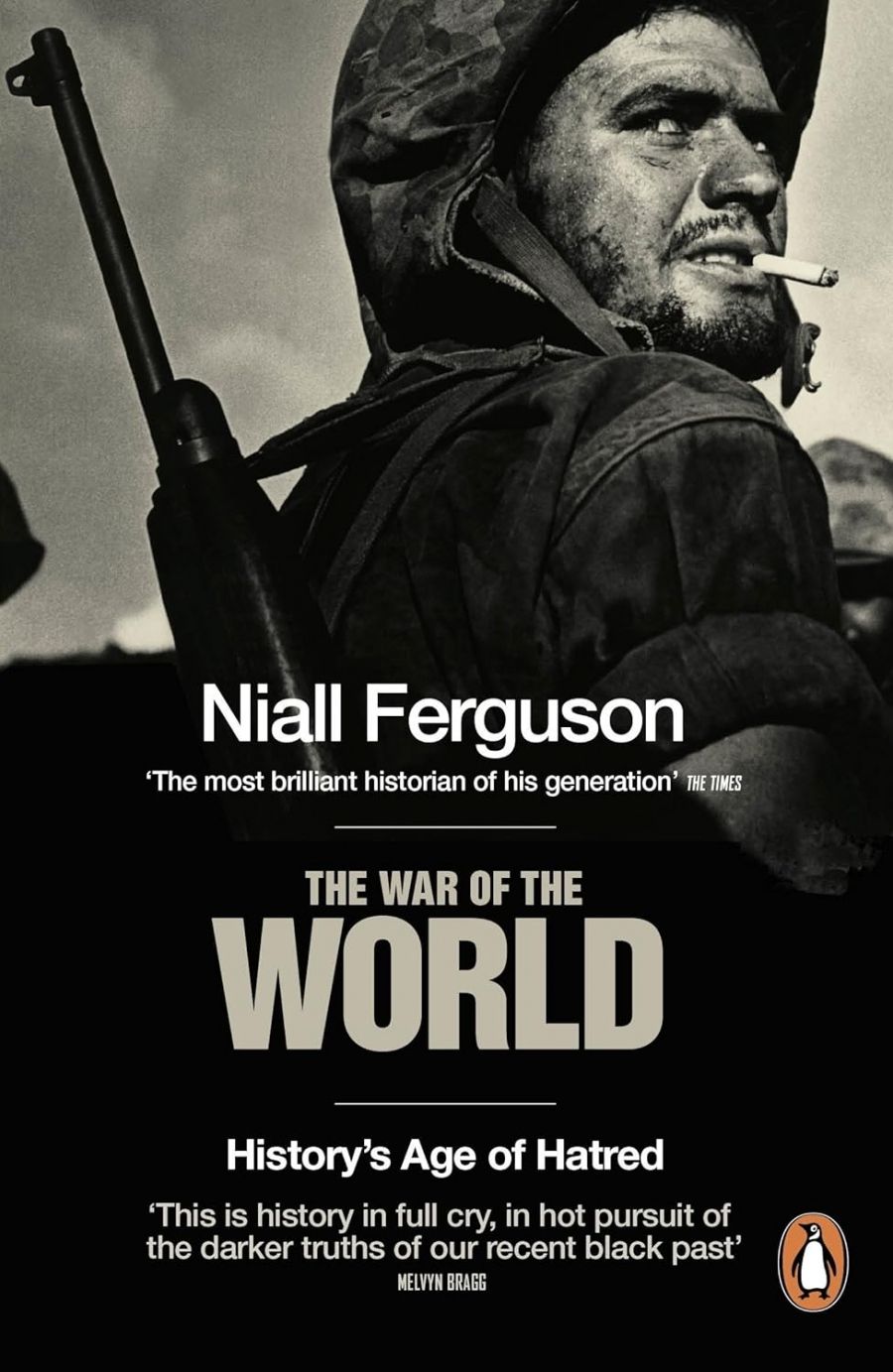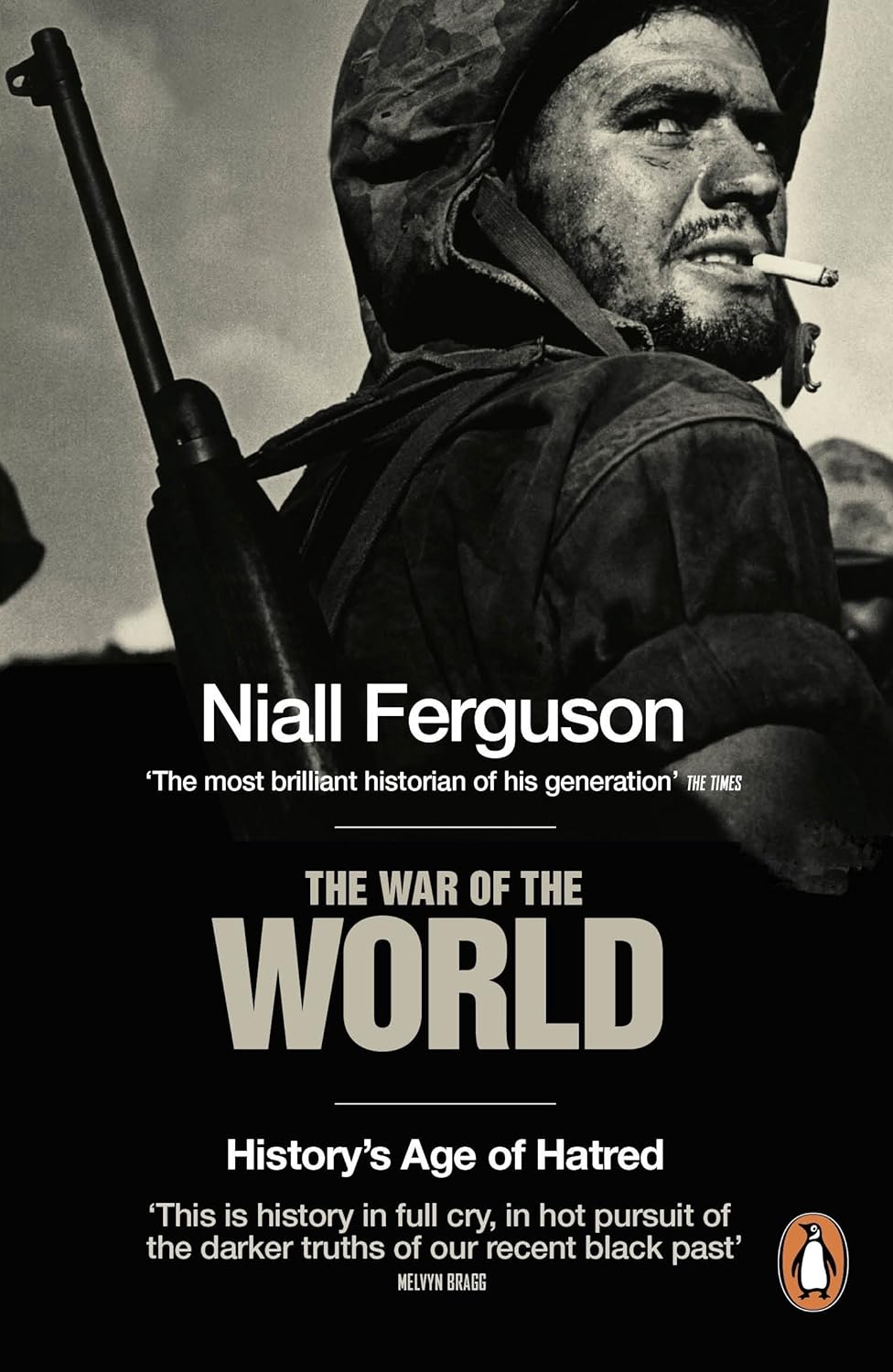
- Free Article: No
- Custom Article Title: History of hatred
- Review Article: Yes
- Article Title: History of hatred
- Online Only: No
- Custom Highlight Text:
Occasionally, a television series on history is accompanied by an excellent book. Jacob Bronowski, anchorman for The Ascent of Man (1973), produced a book of the same name, the more remarkable because it lucidly explained complicated topics in the history of science. John Kenneth Galbraith’s challenging and quietly amusing The Age of Uncertainty (1977) came from another BBC series. Now the history of the twentieth century – or essentially the first half of it – is told and interpreted in this fascinating book by Niall Ferguson, a talented British historian who is a professor at Harvard University.
- Book 1 Title: The War of the World
- Book 1 Subtitle: History’s age of hatred
- Book 1 Biblio: Allen Lane, $59.95 hb, 746 pp, 0713997087
- Book 1 Cover Small (400 x 600):

- Book 1 Cover (800 x 1200):

I wondered, when opening this book, where the title came from; but Ferguson explains that it is a slight alteration of H.G. Wells’s prophetic science fiction book The War of the Worlds (1898). The book’s subtitle is equally dramatic and alliterative, History’s Age of Hatred.
Is it appropriate to proclaim that, of all the centuries in recorded history, this was the century of hatred? Certainly, the book portrays how, during part of that century, most or many Europeans hated or disliked rival religions and nationalities. The Jews, the Slavs, Muslims, Catholics, Protestants, Orthodox Christians and atheists all had their enemies: so did Russians, Germans, English, French, Austrians and other nationalities. Ethnic antipathies divided peoples extending from Ireland and Greece to Poland and Romania, and all the way to Cambodia and Indonesia. Whether hatred, however, is the key word for these varying tensions and animosities is open to argument. In any case, there is no known way of measuring hatred in one century rather than another; and Ferguson himself makes no serious attempt to argue that there was more hatred in the twentieth century than, say, in the time of the Crusades. The first entry which a reader is tempted to seek in the index is ‘Hatred’, but it is not under H nor under other categories that I scanned. The main theme of the book is violence, especially wartime violence.
In essence, there is something shaky in the whole concept of this book. It is not clear whether the author thinks the book is about violence or hatred, and they are very different things. It is not clear whether the book is trying to make a major and damnatory assessment of the twentieth century in terms of all history or simply of modern history. Moreover, the book’s statistical basis for trying to assess the comparative extent of violence during either modern history or the full span of history is shadowy.
In another sense, the book deserves high praise. It would be hard to find a more dramatic survey of violence in the twentieth century, especially in Europe. We are escorted to the battlefields of World War I; we see the Turks slaughtering the Armenians, and the Bolsheviks turning on their fellow Russians. We glimpse the violence of the Japanese troops in China in the 1930s; the Rape of Nanking was ‘not an isolated incident’. We see the Soviet and Nazi German armies behaving ruthlessly toward prisoners of war; we watch the bombing of London and Dresden, Hiroshima and Tokyo; and we are shown the inside of Nazi concentration camps. It is fair to suggest, however, that this is much more a detailed history of violence in Europe than in Asia and Africa, and more a history of violence between 1904 and 1953 than afterwards. Thus the book is close to page 600 before it reaches the armistice of the Korean War, in 1953, and therefore only fifty or so pages remain for the later wars in Africa, Vietnam and Cambodia, the repression in China and other violent episodes.
The problem remains: how violent was the century just ended compared to earlier centuries? The opening sentence of the long blurb on the dust jacket asserts that ‘the twentieth century was by far the bloodiest in all human history’. That sweeping generalisation is watered down in the book’s introduction, where the twentieth century is assessed only as the worst in modern history: ‘The hundred years after 1900 were without question the bloodiest century in modern history, far more violent in relative as well as absolute terms than any previous era.’ To compare the twentieth century with earlier centuries in modern history, Ferguson produces a league ladder of twelve modern wars – headed by the two world wars – and calculates the total of battlefield deaths as a percentage of the world’s population at the time. This ladder, however, is a guide to the bloodiest wars rather than to the bloodiest century. A century with a maze of little wars can be relatively bloodier than a century with dramatic, heavily reported, big wars.
The book does not produce the appropriate statistics needed to justify a claim that this is history’s age of violence, let alone its age of hatred. Even on its own terms, this ladder of twelve wars of ‘geopolitical magnitude’ is deficient because it excludes the Taiping Rebellion of the mid-nineteenth century, which might well have exceeded World War II in bloodiness. The American Civil War, I suspect, should also belong on this list.
At the end of the book, in smaller type, comes an eight-page appendix, which reopens the argument set out emphatically at the start of the book. Entitled ‘The War of the World in Historical Perspective’, it is more thoughtful, subtle and hesitant, and it definitely tempers the opening pages of the book. It actually concedes that the twentieth century, in relative terms, might not have been the worst for Asia, as distinct from Europe. Moreover, this chapter, clearly an afterthought, conveys a strong hint that the twentieth century might conceivably have been no more violent than ‘prehistoric and pre-modern tribal societies’. These last-minute concessions defy the book’s emphatic subtitle, History’s Age of Hatred, and the emphatic title of the introductory essay, ‘The Lethal Century’.
The reader’s puzzlement will not be eased by the opening sentence of the appendix which claims to set out verbatim, for purposes of further discussion, the key sentence used at the start of the book. It substantially misquotes that key sentence. It is unusual to see a book misquoting itself.
If you ignore its drift towards conceptual confusion at the start and finish, the book holds much that is challenging. It views World War I not as the long-expected eruption after years of mounting tension between the great powers but as an event not easy to predict. One financier taken by surprise was the head of Rothschild & Sons, which had much to lose from a major war because its financial portfolio was spread around Europe. Likewise, Ferguson argues that Russia’s defeat in the war against Germany and Austria in 1917 was greatly aided by the desertion of Russian soldiers and by their willingness to become prisoners of war; in short, the collapse of morale in tsarist Russia paved the way for the victory of the Bolsheviks. On the eve of the Fall of France in mid-1940, deserters also led the way.
For the rise of Hitler, Ferguson presents his distinctive views. Thus, Hitler’s sympathisers were fewer amongst the business and military élite than amongst intellectuals and university students: ‘academically educated Germans were unusually ready to prostrate themselves before a charismatic leader.’ On the terrible fate awaiting Jewish citizens in Germany, Ferguson offers this powerful thought: ‘One of the great puzzles of the twentieth century, then, is that the most extreme racial violence in all history had its origins in a society where assimilation was progressing with exceptional rapidity.’ There – I say so with respect – he goes again! He employs the phrase ‘in all history’ when his own key sentences elsewhere throw doubt on such a sweeping statement.
Ferguson’s observations on various other warlike topics are stimulating. Whereas the British empire was supposedly acquired by accidents, the Japanese empire was ‘acquired by incidents’. At times, he explains, the United States was also an ‘appeaser’; and Roosevelt, soon after becoming president, proposed that the Polish Corridor – later a central cause of tension – should be handed back to Germany. Ferguson also argues that the French soon accepted the German armed occupation in 1940 and did not flock to the side of the ‘resistance’ until the tide of victory was seen to be flowing with the Allies. And the great victor of World War II was not the United States but Stalin’s Soviet Union.
This is more a history of Europe than a history of the world in a globalising century. The book contains more on Poland than China, far more on the Balkans than the Middle East. Israel and Palestine barely squeeze in, and the Muslims are largely veiled. Unlike nearly all the books that are midwives to a television series, The War of the World is dominated to an impressive degree by the word, not the picture. The illustrations number only about fifty; the 1917 painting of Berlin at night, the photographs of a bombed Chinese railway station in the 1930s, and a Soviet soldier snatching a bicycle from a German woman (undated, but presumably in 1945), are captivating. The ten maps – seven of them depicting Europe – are excellent, though the depiction of Japan’s outer defensive perimeter during the Pacific War in 1941 is far astray.
The book includes a long bibliography, and advises that the footnotes will be available to readers willing to look up the author’s own website. In a work that represents some ten years of research and probably thirty thousand decisions on matters of fact and shades of meaning, complete accuracy is impossible; but my impression is that the book has a high level of accuracy, if the conceptual dilemma is overlooked.
Perhaps the difficulties of preparing the theme for television created the confusion. In a second edition, it should be relatively easy to eliminate the puzzling and contradictory passages, though the catchy subtitle remains a thorn. And yet Ferguson has enviable virtues, not the least of which are clear and vigorous prose, a fine eye for symbolic and gripping detail, a daunting knowledge of many facets of history, and an independent mind. A quotation on the dust jacket, culled from The Times, calls him the ‘most brilliant British historian of his generation’. Many readers will either not notice or forgive the book’s conceptual dilemma and relish the compelling narrative.


Comments powered by CComment